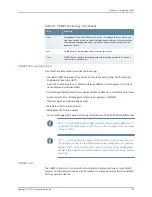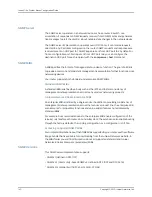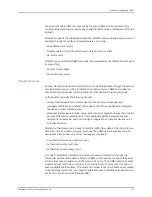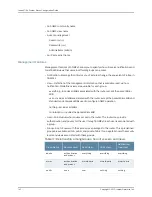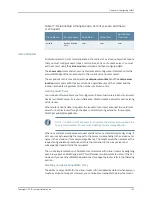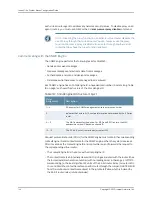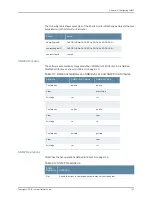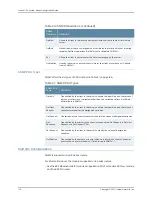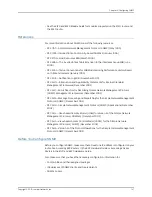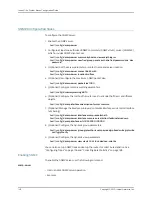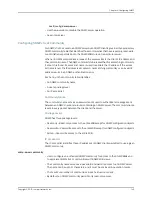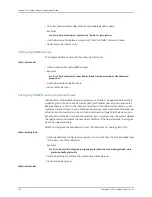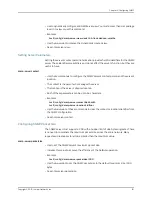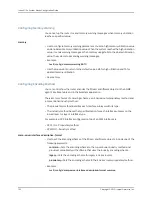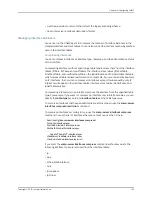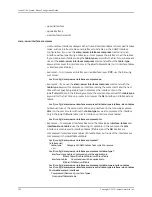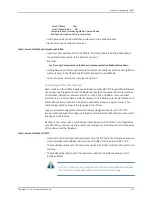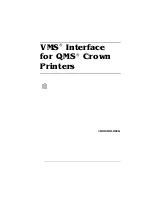
•
Use the
no
version to return to the default, the legacy encoding scheme.
•
See snmp-server interfaces description-format.
Managing Interface Sublayers
You can set up the SNMP agent to compress the number of interface instances in the
standard interface and stack tables. You can also control the interface numbering method
used in the interface tables.
Compressing Interfaces
You can compress interfaces by interface type, table type, and the administrative status
of the interface.
Compressing interfaces without specifying a table type removes them from the interface
tables (ifTable, ifXTable, and juniIfTable), the interface stack tables (ifStackTable,
ifInvStackTable, and juniIfInvStackTable), the ipAddrTable, and the ipNetToMedia table,
which increases table retrieval performance. For example, if you want statistics kept only
on IP interfaces, then you can compress all interfaces except IP; subsequently, only IP
interfaces will appear in the interface tables, interface stack tables, ipAddrTable, and
ipNetToMedia table.
Compressing a table type in an interface removes the interface from the specified table
type. For example, if you want to compress an interface only in interface tables, you can
specify the
table-type
keyword and
interface-tables
as the
TableType
value.
To compress interfaces that have an administrative status of down, use the
snmp-server
interfaces compress-restriction
command.
To compress interfaces according to type, use the
snmp-server interfaces compress
command. To see the list of interfaces that you can remove, use the CLI help:
host1(config)#
snmp-server interfaces compress ?
Atm Atm interface layer
Atm1483 Atm1483 interface layer
AtmAal5 AtmAal5 interface layer
. . .
SonetVT SonetVT interface layer
VlanMajor VlanMajor interface layer
VlanSub VlanSub interface layer <cr>
If you enter the
snmp-server interfaces compress
command without keywords, the
following interface types are removed from the interface tables:
•
ip
•
ppp
•
ethernetSubinterface
•
hdlc
•
ipLoopback
•
ipVirtual
153
Copyright © 2010, Juniper Networks, Inc.
Chapter 4: Configuring SNMP
Summary of Contents for JUNOSE 11.3
Page 6: ...Copyright 2010 Juniper Networks Inc vi...
Page 8: ...Copyright 2010 Juniper Networks Inc viii JunosE 11 3 x System Basics Configuration Guide...
Page 24: ...Copyright 2010 Juniper Networks Inc xxiv JunosE 11 3 x System Basics Configuration Guide...
Page 32: ...Copyright 2010 Juniper Networks Inc 2 JunosE 11 3 x System Basics Configuration Guide...
Page 146: ...Copyright 2010 Juniper Networks Inc 116 JunosE 11 3 x System Basics Configuration Guide...
Page 166: ...Copyright 2010 Juniper Networks Inc 136 JunosE 11 3 x System Basics Configuration Guide...
Page 432: ...Copyright 2010 Juniper Networks Inc 402 JunosE 11 3 x System Basics Configuration Guide...
Page 488: ...Copyright 2010 Juniper Networks Inc 458 JunosE 11 3 x System Basics Configuration Guide...
Page 524: ...Copyright 2010 Juniper Networks Inc 494 JunosE 11 3 x System Basics Configuration Guide...
Page 554: ...Copyright 2010 Juniper Networks Inc 524 JunosE 11 3 x System Basics Configuration Guide...
Page 566: ...Copyright 2010 Juniper Networks Inc 536 JunosE 11 3 x System Basics Configuration Guide...
Page 588: ...Copyright 2010 Juniper Networks Inc 558 JunosE 11 3 x System Basics Configuration Guide...
Page 613: ...PART 3 Index Index on page 585 583 Copyright 2010 Juniper Networks Inc...
Page 614: ...Copyright 2010 Juniper Networks Inc 584 JunosE 11 3 x System Basics Configuration Guide...
Page 632: ...Copyright 2010 Juniper Networks Inc 602 JunosE 11 3 x System Basics Configuration Guide...

